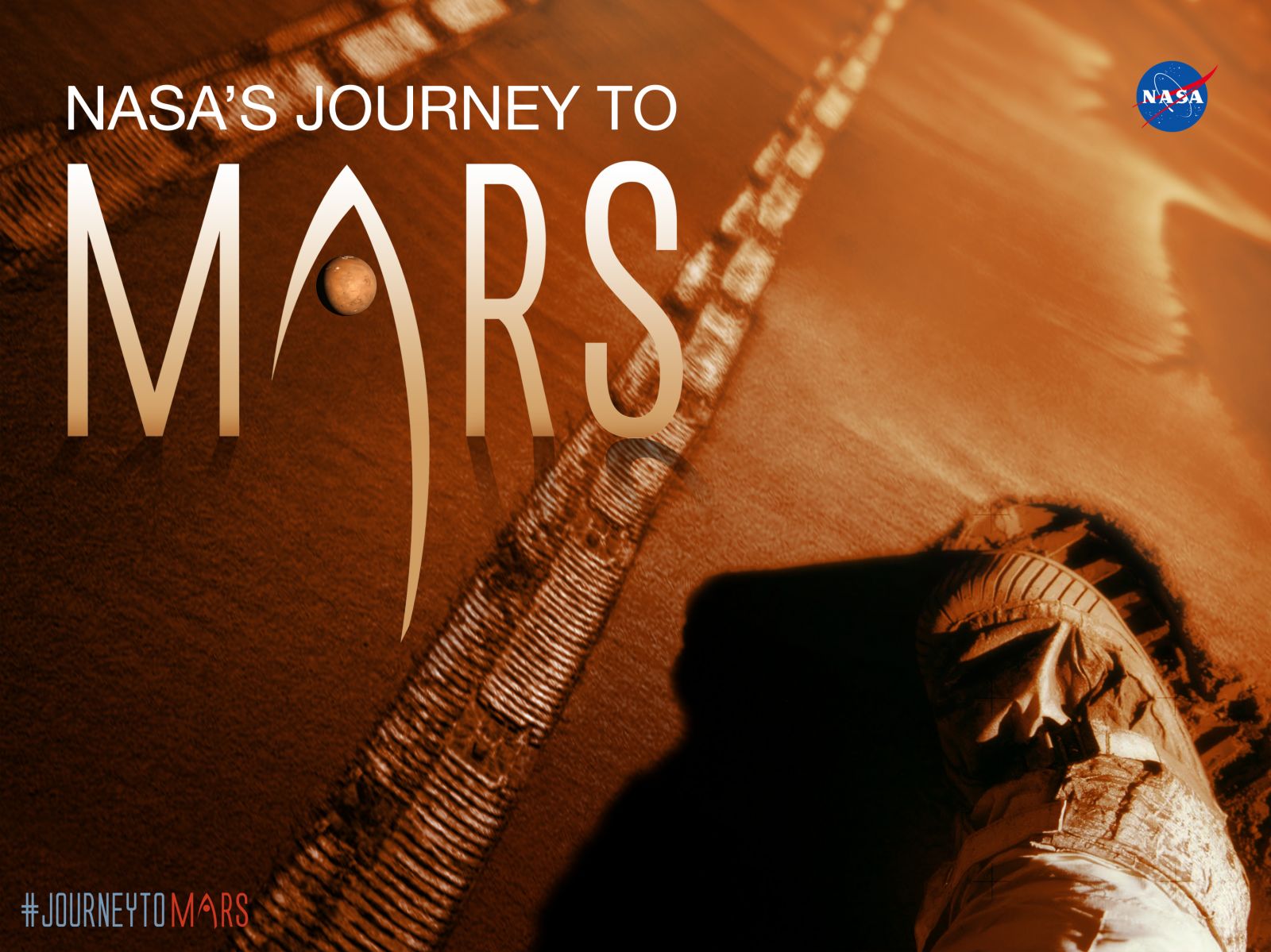
Here’s your chance to influence how NASA will fulfill its agency-wide goal of sending humans to Mars in the 2030s for a sustained period of time.
NASA has just announced a cash prize contest seeking input from the public for ideas on how to develop the infrastructure needed to establish a continuing human presence on the Red Planet starting about two decades from now to achieve the agency’s “Journey to Mars” enterprise.
The contest is named “Space Pioneering – Achieving Earth Independence,” in line with NASA’s long-term solar system exploration strategy “of ‘pioneering space’ for this and future generations.”
At virtually every forum, NASA officials explain that the agency’s overriding goal is embarked on the ambitious task of creating a viable and affordable plan for “boots on Mars.”
Although the 2030s seems a long way off, the task of sending astronauts to the Red Planet and then establishing a continuing human presence is daunting—from the technical, scientific, budget, and political perspectives.
NASA has started on the long road to Mars and is currently developing the launch from Earth infrastructure in the form of the Orion deep space crew capsule and the mammoth SLS Heavy Lift Launch booster. But those immense programs alone are insufficient for the huge task at hand—much more is needed.
Therefore, on May 5, NASA announced a challenge seeking public input for ideas on achieving a sustained human presence on Mars as part of the agency’s “Journey to Mars” initiative.
NASA wants you to gather your thoughts and submit detailed ideas “for developing the elements of space pioneering necessary to establish a continuous human presence on the Red Planet.”
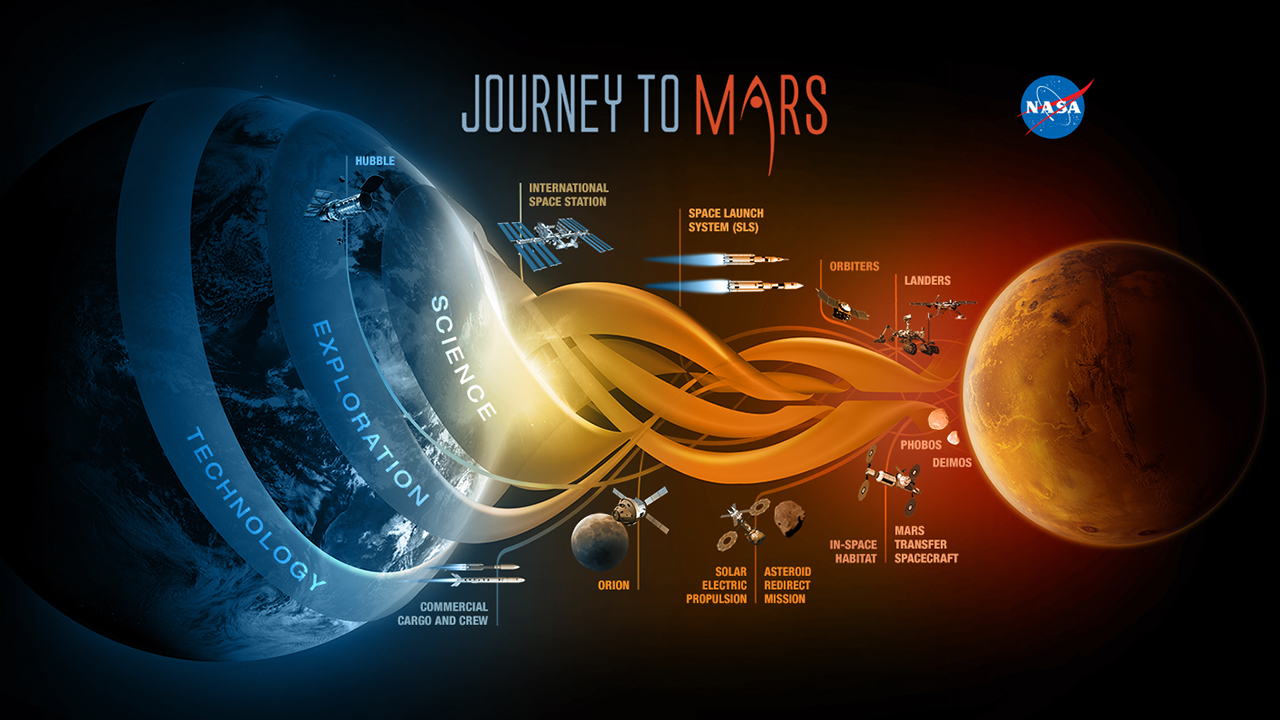
Among the basic elements NASA suggests proposals for are related to shelter, food, water, breathable air, communication, exercise, social interactions, and medicine.
But to endure the harsh extremes of the Martian environment—consisting of an ultra thin atmosphere less than 1 percent as thick as Earth’s, a constant 24/7 bombardment of ionizing, and harmful solar and cosmic radiation, frigid daily nighttime temperatures dipping below those in Antarctica, and the absence of liquid water on the surface—future Martian visitors and settlers will need to be ultra resourceful and creative to survive.
Although Mars had oceans of surface liquid water billions of years ago in the ancient past, Mars today is a cold, dry, desiccated, and nearly forbidding world.
Yet Mars has been endlessly fascinating Earthlings for centuries as the most Earth-like planet, as we seek to determine if it ever harbored life, past or present.
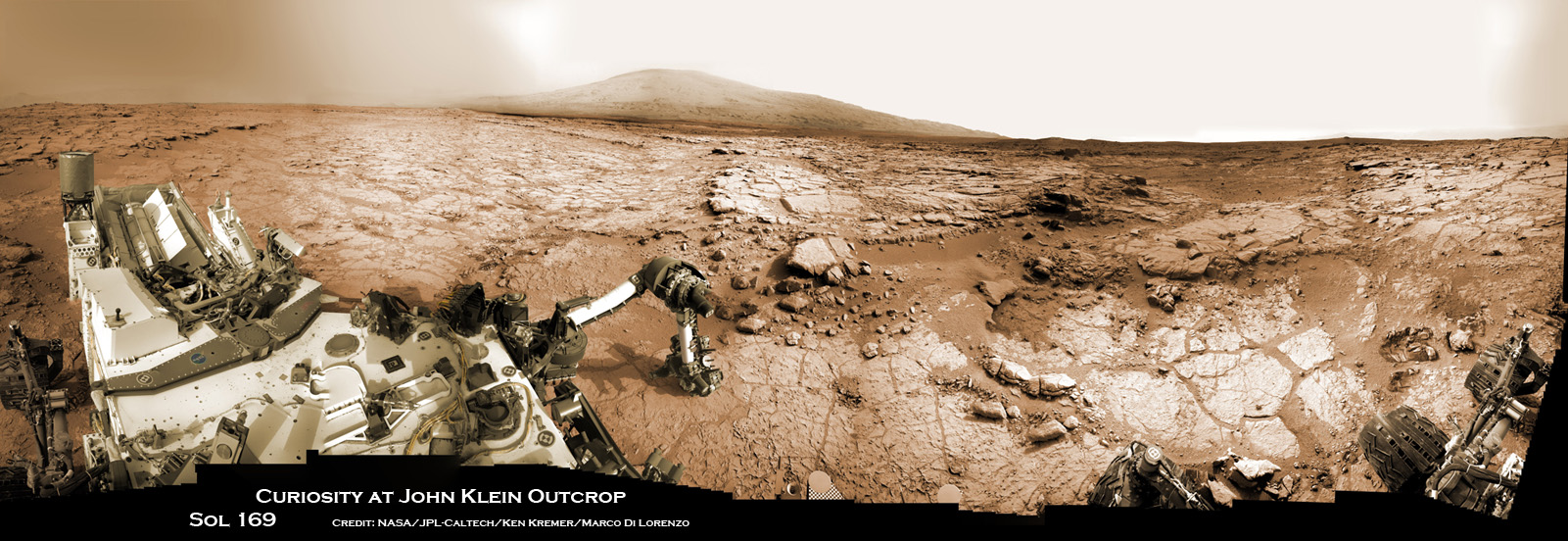
Since it’s impractical to bring all necessary supplies from Earth, due to the astronomical costs, humans explorers will need to “live of the land” and establish viable methods for “in situ resource utilization,” or ISRU.
Therefore, NASA is encouraging contest participants to “consider innovative and creative elements” beyond the well-known basic examples toward the goal of “Space Pioneering – Achieving Earth Independence,” enabling the establishment of a continuous human presence on the Red Planet.
The “Space Pioneering” cash prizes consist of a maximum of three awards at a minimum of $5,000 each. NASA says the total award pool amounts to a maximum of $15,000.
The deadline for submissions is July 6, 2015.
Here are the basic rules:
“Participants are asked to describe one or more Mars surface systems or capabilities and operations that are needed to achieve this goal and, to the greatest extent possible, are technically achievable, economically sustainable, and minimize reliance on support from Earth.”
Ideally, reliance on Earth would be eliminated.
Only a written submission is required for this “Theoretical Challenge” that will be evaluated by NASA, and awards will only be granted if they meet NASA’s criteria.
NASA says you don’t have to transfer exclusive intellectual property (IP) rights to the agency. Instead, NASA will grant the awardee(s) “a non-exclusive license to practice their solutions.”
Submission details can be found at this link.
NASA is now focused like never before on sending astronauts to Mars.
“We are closer to getting Humans to Mars than ever before in the history of civilization,” says NASA Administrator Charlie Bolden.
There is plenty of scientific justification for exploring Mars first with robots and next with humans.
“Mars matters because it might help us unravel the mystery of how life started on Earth,” says Bolden.
NASA’s robotic explorers, in the form of orbiters, landers, and rovers, are already paving the path for future human explorers.
NASA currently has an armada of five spacecraft conducting intensive and long duration investigations at Mars, circling overhead and driving on the surface.
The orbiters include both older spacecraft, Mars Odyssey (MO), Mars Reconnaissance Orbiter (MRO), and the recently arrived MAVEN orbiter.
They are fortified by two orbiters from ESA and ISRO, Mars Express (MEX), and Mars Orbiter Mission (MOM).
Sister rovers Curiosity and Opportunity are roving the Red Planet’s surface and have found habitable zones, signs of past liquid water, organic molecules, and periodic low level venting of methane (CH4).
The ISS is also heavily involved in enabling the journey to Mars, by testing out the technologies required to sustain humans in space for many years, working toward developing closed loop life support system, and checking out the long term effects of microgravity on the human body.
Key to this effort is the newly started, first ever one-year ISS mission, involving NASA astronaut Scott Kelly and Russian cosmonaut Mikhail Kornienko.
The Orion deep space crew capsule that will transport astronauts to Mars completed its first mission in December 2014 and was virtually flawless.
NASA is also simultaneously developing the Space Launch System (SLS) heavy lift rocket to propel Orion to Mars.
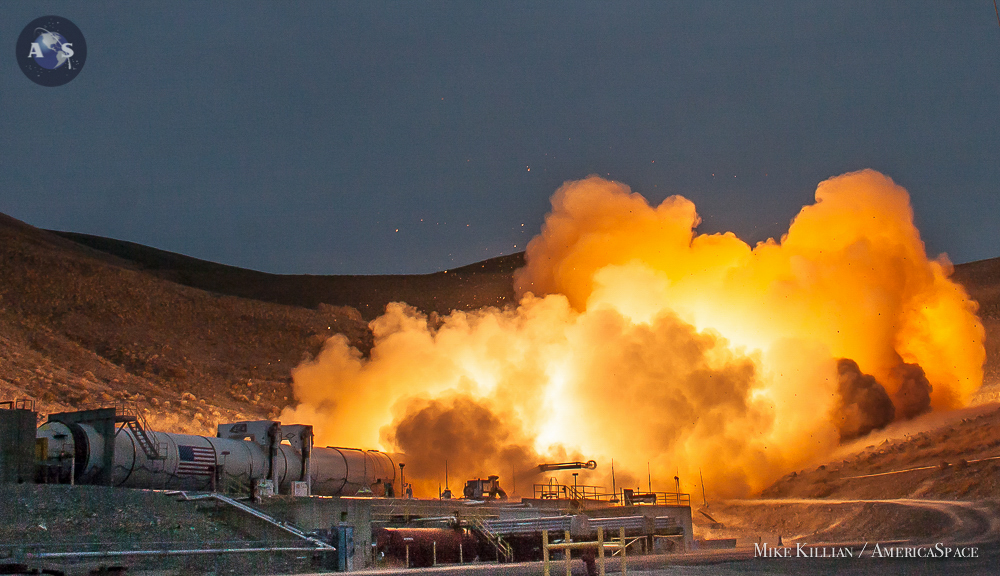
But even more hardware is needed, in the form of habitats, Solar Electric Propulsion, and Mars landers, habitats, and ascent vehicles.
NASA also welcomes international and commercial participation.
And when we go, we should go as a planet, NASA astronaut and science chief John Grunsfeld told AmericaSpace.
“A great path” lies ahead for “science and launching humans to Mars,” said John Grunsfeld.
“NASA’s space science knowledge will allow us to do the work … including on the ISS … that will allow us to move forward so we can launch people to Mars in the next couple of decades. When we go to another planet, specifically like Mars that’s the only planet in our solar system that we could actually live on, then we shouldn’t go only as one country or another country or in a race. We should go to Mars as ‘Humans,’ leaving planet Earth, to another planet that we are going to live on,” Grunsfeld elaborated.
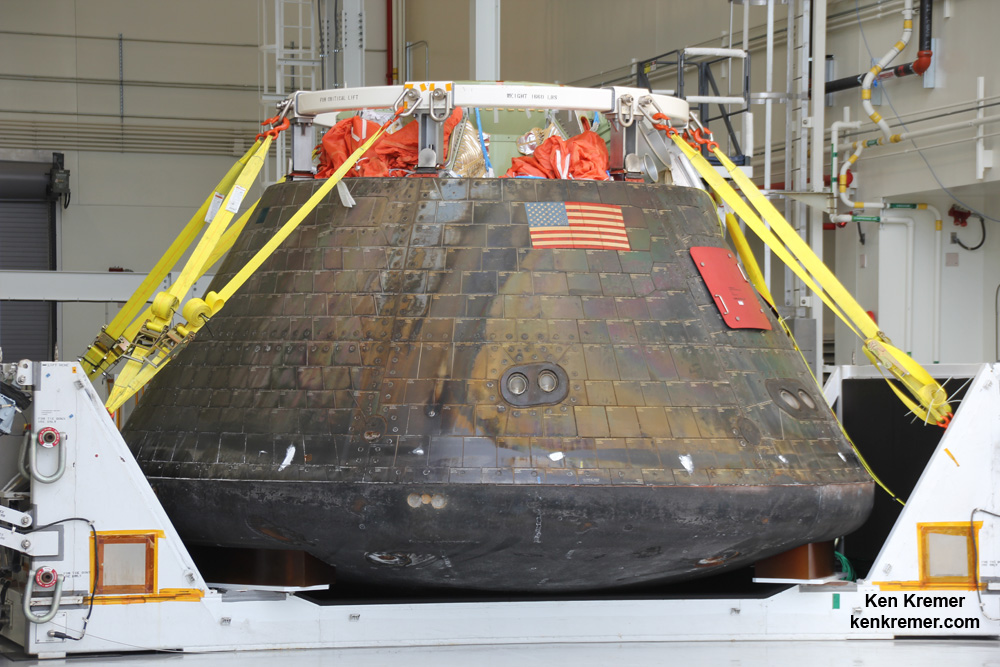
The journey to Mars is not easy. It will take multiple decades of time and the support and money of multiple U.S. presidential administrations.
You can be part of making Mars happen, and NASA now seeks your input.
Stay tuned here for continuing developments on all aspects furthering NASA’s Journey to Mars.
Ken Kremer
Want to keep up-to-date with all things space? Be sure to “Like” AmericaSpace on Facebook and follow us on Twitter: @AmericaSpace
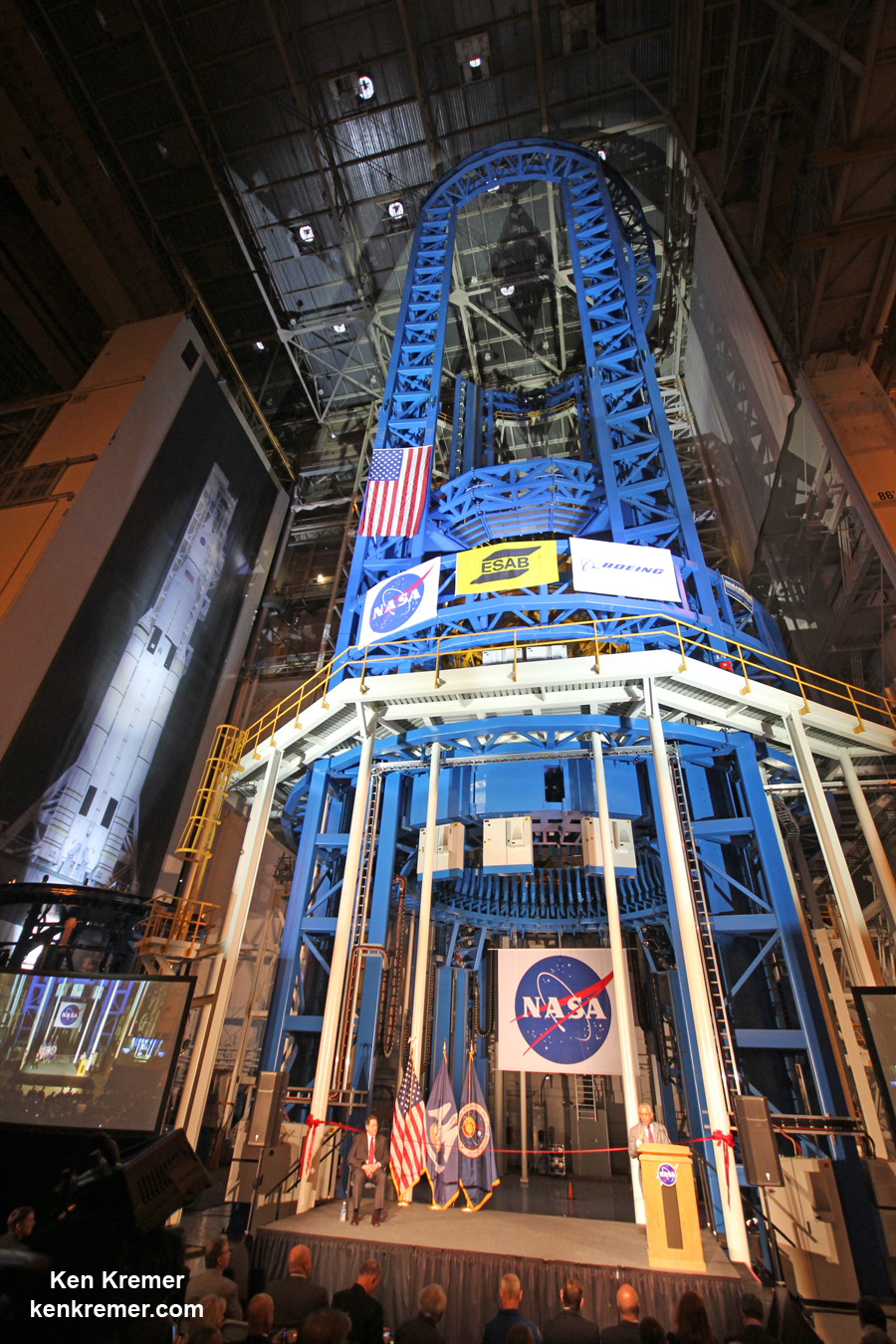




The cosmic ray rats are telling us we cannot go anywhere without going to the Moon first.
The adjective “Orwellian” is becoming the best descriptor of the space agency. Everything they are doing is pretty much the opposite of what it takes to expand the human presence into space.
We have to go to the Moon before we can go anywhere else. There is no other place to acquire the water-as-shielding, assemble, test, and launch the nuclear spaceships required. As long as NASA refuses to acknowledge this then Mars is just a distraction. NASA is being used to subsidize the NewSpace LEO business plan and all this Mars talk is designed to keep that scam out of the spotlight.
“The “Space Pioneering” cash prizes consist of a maximum of three awards at a minimum of $5,000 each.”
What a joke.
“NASA is now focused like never before on sending astronauts to Mars.”
They don’t want anyone talking about going to the Moon. They underfunded the SLS with the goal of starving it to death. They are not going to Mars- they are staying in the dead end of LEO. That’s the focus.
“When we go to another planet, specifically like Mars that’s the only planet in our solar system that we could actually live on, then we shouldn’t go only as one country or another country or in a race.”
Throwing the B.S. flag on that. We can’t live on Mars any more than we can live on the Moon or any other airless body soaked in cosmic radiation. Anyone who wants to “live” on Mars wants to exist in the equivalent of a coal mine- with no coal. A nightmare existence. Not enough solar energy to sustain any industry so it’s nuclear power all the way baby.
“Participants are asked to describe one or more Mars surface systems-”
Like I just said, nobody is going to live on the surface or wander around for very long before they accumulate a lifetime dose. It will be life underground. Anyone born there will dream of living on Earth- but because of the gravity will be debilitated their entire life and probably have to visit here in a wheelchair.
From another thread:
While NASA publicizes LEO and Mars efforts and pushes entrepreneurial solutions any real progress in space exploration requires the anti-thesis of this policy. Abandoning the dead end of LEO, ignoring Mars for the foreseeable future, and returning to the Moon with a public works project on a never before seen scale is the only logical path.
The prophet of space colonization, Gerard K. O’Neill, figured out the Moon was the master key to open the door to space in the 70’s. What radically changed the situation even more in favor of developing the Moon was the 2010 evidence of ice deposits.
The ice on the Moon is the enabling resource that should be the central focus of all space advocacy. The only place to acquire the water-as-shielding, assemble, test, and launch nuclear missions is the Moon. It follows that the only revenue generator in space for now is the GEO satellite industry- and the only place to assemble water-shielded human-crewed space stations to supercede the present satellite junkyard is in lunar orbit using Super Heavy Lift Vehicle wet workshop upper stages. The assembled stations can transit back across cislunar space into GEO and capture the over 100 billion dollar revenues of that industry. This is the path to expanding the human presence into space- not LEO tourism. That this path bypasses LEO and is the kiss of death to the NewSpace business plan is the most inconvenient truth of all.
“The ISS is also heavily involved in enabling the Journey to Mars, by testing out the technologies required to sustain humans in space for many years, working towards developing closed loop life support system and checking out the long term effects of microgravity on the human body, and more.”
30 years of space stations going in endless circles in the dead end of LEO is ENOUGH!
The space station to nowhere is a hole in LEO that 3 billion dollars a year disappears into. It does not have any capability to “develop” a closed loop life support system- and the solution to microgravity debilitation was tested in 1966 on Gemini 11: tether generated artificial gravity.
An artificial environment with Earth gravity and near-sea-level-radiation is the requirement but NewSpace is all about going cheap so the experiments using human beings as radiation and debilitation lab rats go on. There is no cheap.
I’m afraid this is nothing more than just a PR gimmick. In my own personal library, I have shelves-worth of crewed Mars mission studies going back decades… and that represents just tiniest fraction of what NASA already has in its archive. The problem is not coming up with some new idea. The problem with establishing a permanent presence on Mars or anywhere beyond LEO is not a lack of ideas. It is a lack of national commitment to cough up the resources (i.e. lots of cash for decades) needed to develop and field the required enabling technologies (long-term life support, nuclear power and propulsion, artificial gravity, radiation protection, extraterrestrial resource extraction, large-scale space construction techniques, etc.) as well as develop and build the required infrastructure from the ground to LEO to the Moon and beyond. NASA isn’t going to be able to do that with its current anemic budget (which is less than half of what it was in real dollars during the peak of the Apollo program – the last time there was any real national commitment towards a space goal) nor the way it is currently structured.
So here’s my bright idea for establishing a permanent human presence on Mars or anywhere beyond LEO and NASA can keep its prize money: Restructure and streamline NASA, double its budget and commit to doing so for the foreseeable future.
http://www.army-technology.com/news/newsus-to-supply-3bn-v-22b-block-c-osprey-helicopters-to-japan-4570362
As I made brief mention of in a thread about the toxic dragon abortion; another vertical flight monstrosity that showcases how powerful greed is. For those that think the 3 billion a year on the ISS is a big deal consider this political payback from the Japanese. For the same amount Japan is acquiring a small force of transport aircraft that can lift a hundred or so troops at a time. Only a dozen at most will be operational at any given moment and they cannot lift the 24 fully equipped troops advertised (the cabin is too small). The over-priced junk that even Dick Cheney could not kill because parts are made in every congressional district that matters.
The Osprey is just one example of the vast and really unbelievable amount of money the defense industry spends while the Human Space Flight budget is literally a drop in the bucket in comparison. This list of DOD projects (many of which are canceled after the money is spent) of dubious worth is long and adds up to not the few tens of billions of the entire NASA budget but hundreds of billions of dollars poured into cold war toys. The ultimate example being the F-35 stealth fighter. A single engine tactical aircraft that will cost over the next half century a staggering one trillion dollars. Just one of these small aircraft costs as much as a 1300 foot, 165,000 ton super container ship. So a few hundred of these planes that can fit on a tennis court equates directly to all of these largest-ships-ever-built that now travel the oceans of Earth.
The absurdity of using the B-1 bomber, designed to penetrate sophisticated air defense missile networks and drop H-bombs on the Soviet Union, to drop million dollar laser guided bombs on hillside shanties (aka terrorist enclaves) is why we have no space program. Any objection, and indeed, any suggestion that a Military Industrial Complex actually exists, is met with scathing derision and accusations of not “supporting the troops.” As a sidenote it is also a “rumor” that an unknown amount of money went under the table from the space shuttle development program into the troubled B-1 program.
For those who think defense should be kept separate from space the reality is that space and defense are joined at the hip. The DOD just dropped 5 billion dollars on “space control.” This was not a carefully legislated months long debated addition to the a government agency budget like NASA- they came up with this on short notice out of pocket change. Consider what 5 billion would do for the Human Space Flight budget.
The most interesting scenario to me concerns the unavoidable replacement cost of legacy strategic nuclear systems conservatively estimated at a trillion and a half dollars over the next two presidential terms. The cost of the Ohio replacement program is by itself a truly astonishing figure when it is realized submarines may not be able to hide anymore- and that makes them worthless. The solution is to move the nuclear deterrent into deep space beyond lunar orbit on human crewed spaceships. It would cost about the same and surprisingly much of the technology crosses over.
I surprise myself here, but I have to agree. Just taking a miniscule amount (relatively) from the military budget would do wonders for NASA.
“I have to agree.”
The NewSpace mob does not agree; they depend on the NASA budget NEVER going above the present 18 billion or so and always use this set-in-stone-unchanging-fact to argue against anything not in keeping with the cheaper-smaller-better LEO tourist business plan. This will do nothing but strand humankind in the dead end of LEO for another 40 years.
In my view Paul Spudis has the correct solution; he has on several occasions written about a “Space Navy” as a separate agency. Having been in on the birth of the Department of Homeland Security I know this is not impossible. The DHS was brought into existence and I was made a part of it in a jiffy. The question is how to justify such a Human Space Flight-Beyond Earth Orbit organization? There are three reasons;
1. The nuclear deterrent is deteriorating and all three main players in the game, America/Russian/China have it in their best interest to not have weapons on hair trigger alert minutes away from their targets. I described moving the weapons into deep space on this thread.
2. Planetary protection- Chicxulub/Tunguska/Chelyabinsk events are a good enough reason by themselves and all three nuclear nuclear powers can task their spaceships to intercept impact threats.
3. Survival colonies. Since it will take lunar resources to build a fleet of nuclear propelled and armed spaceships it only makes sense to have lunar colonies with women and sperm banks (Amazon women on the Moon) in case a global pandemic wipes out the human race. It sounds crazy but….yes, I am talking about all of them being young women. It only makes sense.
And of course these spaceships can do some exploring. If you have such Amazon-crewed space battleships out there the astro-cosmo-taiko-femnauts might as well go somewhere and Mars is actually a poor destination if you have the capability to take some mini-subs to the ocean moons of the gas giants.
I highly doubt that the “NewSpace mob” doesn’t want NASA to have more money. It is also in their (or to be complete also in mine) best interests that NASA has lots of money to spend. On what is another discussion.
I mention the Japanese because they have their own very capable launcher- that in fact makes the hobby rocket look like the cheap junk it is. Built by Mitsubishi. That Japan drops three billion on a handful of some super-expensive and not very efficient glorified cargo planes in the interest of playing ball with the DOD is a perfect example of why defense is easy money and space (as in Human Space Flight) is hard money. Norm Augustine could explain how that works. Cold war toys don’t really have to work all that well and since much of the development cost is “classified” that is a license to steal. Spaceships, on the other hand…..
“-doubt that the “NewSpace mob” doesn’t want NASA to have more money.”
Not for SLS, not for Moon return. No doubt of that.
In 1976 Gerard K. O’Neill’s The High Frontier was published and his conclusion that besides Earth no natural bodies in the solar system were suitable for human habitation. The solution to space colonization being spinning artificial hollow moons- the basic concept of which dates to 1929 and the Bernal Sphere.
In 2006 Eugene Parker’s article in Scientific American, Shielding Space Travelers, described the problem presented by the heavy nuclei component of galactic cosmic radiation. His conclusion being the only guaranteed solution to the cosmic ray hazard being 5 meters of water or plastic shielding- which works out to about 500 tons for a small capsule.
What O’Neill and Parker are explaining to the public with their work is the “human” in Human Space Flight comes first. The environment required is the environment we evolved over millions of years to survive in- Earth gravity and near-sea-level radiation. NASA is essentially denying human factors in their dealings with the public by leaving this out.
The only place human beings can live for a short period without massive shielding and artificial gravity is Low Earth Orbit and this domain, mistakenly perceived as “space”, protected by the magnetosphere and Van Allen belts, is a dead end. LEO is about 2/3 of the way up out Earth’s gravity well and is not space. All this leads in a roundabout way to the ice on the Moon.
Except going to the Moon requires a public works project that is anathema to NewSpace ideology. This, along with the defense industry wanting nothing to do with the lower profit margin of spaceships, means humankind will go nowhere for the foreseeable future unless the public demands action. O’Neill found the justification for public support in the Space Solar Power industry- essentially limitless energy and an end to poverty on planet Earth.
This is why NewSpace is the worst thing that has ever happened to space exploration.
In effect, the future of space exploration is being determined by an ideological battle. On the one side is the NewSpace LEO business plan and the Military Industrial Complex and on the other is the the vision of Gerard K. O’Neill showing exactly how to expand into the solar system and vastly improve the human condition on Earth. It is obvious right now who is winning this battle.
Boozer is back at attacking Orion and SLS again
http://www.thespacereview.com/article/2737/1
http://www.thespacereview.com/article/2743/1
As usual the New Spacers are being difficult
rboozer160p · 2 days ago
“It’s high time space advocacy stops pretending there is a pot of gold an administration away and starts exploiting new ways of doing business to maximize the taxpayers ROI.”
So true, and therein the insanity lies. That’s what I have been telling people like Matt Wiser, Marcel Williams, Nelson Bridwell, etc. for many years.
Report
JH That was the money quote from comments on the articles you linked.
Hi John,
Having waded through Boozer’s “logic” before had no interest in going doing it again, so I did key word searches in both articles to see the context of the quote, but did not find that it in either.
I will take your word it is there and I am somehow missing it.
That being said, the “pretending there is a pot of gold ” that can allow “exploiting new ways of doing business to maximize the taxpayers ROI” is very interesting; but I suspect not in any way Boozer would intend.
Isn’t “exploiting new ways of doing business to maximize the taxpayers ROI” exactly what “commercial space” is supposed to be all about.
iPhone comment, so please bear with me Joe,
The operative term in your comment was “supposed to be”. NewSpace is supposed to be about getting things done affordably. Much of what is done now is a mockery of commercial operations. To me, it should be deliver and then get paid, not lobby and then….
The quote was burried in the comments I was skimming. It probably doesn’t mean the same thing to Rick as it does to me.
An example of the way you and I disagree is on depots. I see them as viable if done without government funding while you don’t see it happening that way at all. The thing is that if it is government funded, it is competing with all other NASA projects. As such, NASA projects tend to disparage other agency projects in hopes of getting that funding for their own. So depot are in opposition to SLS. Commercially there is no reason for dispute.
Cutting this short iPhone keyboard annoying.
I’ll try again Joe,
Until real markets are being served in LEO, it will continue to be the circus we see now. Real markets require reliable, frequent, and affordable access to their destination whether it is in LEO or Timbuktu. Markets and transport will ratchet each other up if there is real competition.
When you can ride in a comfortable cabin with your gear for $10k a pound, then you can do real work. That would be about $5m for a month. The possibilities that I am aware of include pharmaceutical material biological research as well as earth observation and astronomy. Tourism may get real at those price points. There are a dozen or so other possibilities I have heard of. When LEO is industrialized, then lunar and other destinations will come down in cost to the point of affordability. The worst thing in space advocacy is the idea that one project must take precedence at the expense of others. Second worst thing is the fixation on taxpayer funding for debatable projects. McDonalds doesn’t lobby for money to build a store, they build it and pay taxes the other direction.
Joe,
Good morning. My answer should have been that basing any plan on a funding increase, when there are no signs of one coming, is a plan doomed to failure.
“Until real markets are being served in LEO, it will continue to be the circus we see now.”
“basing any plan on a funding increase, when there are no signs of one coming, is a plan doomed to failure.”
Agreed on both points, though I would extend LEO to BEO as well.
The problem is (in the case of space) a market has to be created without private, commercial (what ever anyone wants to call it) support in order to stimulate that private investment. Additionally (as you point out) that will probably have to be done without any significantly increased funding (at least in this country – be a good idea to keep track of the Russians and Chinese).
That is going to be a challenge.
I see some signs of commercial developing markets. I think the markets that eventually emerge will be ones few people see at this time. How many people saw on line video games as a major market in the 70s, or bottled water for that matter. IMO, the strengths of the market based development are exemplified in the examples of Rotary Rocket, Iridium, Beal, and Kistler. They failed, they are out of the way. The real development of Mars will eventually come from people with skin in the game, just like the moon, NEOs, and the rest of the solar system.
Not by the examples of Virgin Galactic getting the taxpayers of New Mexico to build a quarter billion dollar spaceport that looks like a bad investment at this time. I don’t mind millionaires screwing up and losing their money. I have a real problem with them screwing up on the taxpayers money. I also have a problem with clearly flawed programs operating mainly for political gain or as a jobs program.
My passions shouldn’t hurt you when I’m wrong, just me. They should help you when I’m right in the form of an increased tax base. That is the philosophy I would like to see in commercial spaceflight.
John, great points with regard to markets and commercial space. I especially liked your point about McDonald’s.
There does not currently exist a commercially viable funding path for commercial space that offers a hope for sizable income growth and ROI needed to balance the industry’s high betas (projects taking years longer than expected, rockets blowing-up, gov’t contracts suddenly being canceled, etc.) sufficiently to attract the hundreds of millions in up-front commercial investment required to build revenue generating products. Warren Buffet once said, “…worst sort of business is one that grows rapidly, requires significant capital to engender the growth, and then earns little or no money. Think airlines.” And commercial space. This is the albatross around commercial space’s neck that dictates NASA in particular, and the gov’t in general, will remain the single milk cow in the field upon whose utter all must tug for funding.
Thanks Jim,
I think a lot our disagreements disappear if I’m not going into your pocket. The emerging markets I see May or May not happen. It will be for history and reality to decide, not discussion. I expect them to start small and expand or disappear as reality dictates. I would prefer that taxpayer money. to go to fund long shots in the commercial sector.
(1) “I think a lot our disagreements disappear if I’m not going into your pocket.”
(2) ” I would prefer that taxpayer money. to go to fund long shots in the commercial sector.”
Agree on (1), but (2) is confusing would not taxpayer money going into long shot commercial ventures be the definition of reaching into someone’s pocket?
I typed it wrong. Taxpayer money NOT go to……. Thanks for the catch.
No problem.
Can now agree with (1) and (2).
“LEO is about 2/3 of the way up out Earth’s gravity well and is not space. All this leads in a roundabout way to the ice on the Moon.”
A couple years ago when I was still allowed to comment on various space forums I noticed many of the NewSpace arguments against HLV’s (now re-branded as Super Heavy Lift Vehicles)used the hobby rocket as an example by comparing it to the space shuttle. I began replying to these comments with the fact that the space shuttle was in fact a Saturn V class launch vehicle and completely outclassed the inferior lift SpaceX vehicle.
The space shuttle just wasted most of it’s lift on wings, landing gear, airframe, etc. The NewSpace fans did not like this argument.
When I point out that LEO is a comparitively limited high altitude domain that tops out a couple hundred miles up with a ceiling just below the Van Allen belts this does not make NewSpace fans happy either. Velocity-wise LEO is about 2/3 of escaping Earth’s gravity well. The “edge of space” is really found at the edge of this escape velocity 20,000 miles up above the Van Allen belts. This is where the GEO satellite junkyard is found and since this industry is where the majority of all space industry revenues come from then GEO is really what NewSpace should be talking about. Except they don’t and suggesting as I do that LEO is not really space seems to drive them nuts.
This would lead one to believe that NewSpace is a tourist scam. There is no industry in LEO- not compared to GEO. The only money to be made is in uber-rich tourists and even this depends on taxpayers subsidizing most of the cost of such vacation packages. The evil genius of a certain internet entrepreneur in using the space station to nowhere as an opportunity to build a commercial rocket launch business has to be appreciated. Now he is gunning for DOD dollars. It ain’t space exploration even though that is what the taxpayer paid for.
It’s a scam.
How does this lead in a roundabout way to the ice on the Moon? The revenue is in GEO but human beings cannot stay above the Van Allen belts because of solar events and cosmic radiation.
Replacing the satellite junkyard with massively shielded human-crewed space stations would solve the space debris problem and improve connectivity by an order of magnitude.
The only practical source for those thousands of tons of water shielding is the ice on the Moon. Assembling Super Heavy Lift Vehicle wet workshops in lunar orbit and transiting these stations back across cislunar space to GEO is the next step in space exploration- not Sarah Brightman singing in microgravity.
LEO tourism is a dead end. What NewSpace should be looking to government support for is going back to the Moon. Halfway to anywhere in the solar system is not 200 miles up- it is 20,000 miles up. The way to get humans on site in the over 100 billion dollar a year GEO telecommunications industry is to go to the Moon first.
For those who think LEO is such a fantastic place to make money with all those non-GEO satellites think again; high altitude airships are “poised” to replace almost all of them. Hydrogen filled dirigibles hovering above 100,000 feet have, if I recall, about 500 miles of coverage out to the horizon which makes them the ultimate cell phone tower/earth observation platform. With solar cells and clear weather at that altitude they can stay up for months in most latitudes- and then come down for maintenance and go back up again. In fact, with enough of them in the air as relay stations you don’t even need GEO satellites.
How is that for a disruptive technology? Who would have thought- Zeppelins.
“A couple years ago when I was still allowed to comment on various space forums ”
Gary mentions being banned on other forums! Drink!